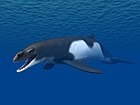Herpetocetus
| Herpetocetus Temporal range:
| |
|---|---|

| |
| Herpetocetus bramblei | |
| Scientific classification | |
| Domain: | Eukaryota |
| Kingdom: | Animalia |
| Phylum: | Chordata |
| Class: | Mammalia |
| Order: | Artiodactyla |
| Infraorder: | Cetacea |
| Family: | Cetotheriidae |
| Subfamily: | †Herpetocetinae |
| Genus: | †Herpetocetus van Beneden, 1872 |
| Species[1] | |
|
†H. scaldiensis van Beneden, 1872 (type) | |
Herpetocetus is a genus of cetotheriid mysticete in the subfamily Herpetocetinae. Considerably smaller than modern baleen whales, Herpetocetus measured only 3 to 4 meters in length.[2] Additionally, due to the structure of its jaw, it was unable to open its mouth as wide as modern baleen whales, making it incapable of lunge feeding. [2]
Taxonomy
[edit]There are four recognized species of Herpetocetus: H. scaldiensis,[3] H. transatlanticus,[4] H. bramblei,[4] and H. morrowi.[5] An additional unnamed species from Japan has been referred to the nomen dubium Mizuhoptera sendaicus in the past,[6] but the undiagnostic nature of the holotype of the latter means that it cannot be confidently referred to M. sendaicus.[7]

Survival into the Pleistocene
[edit]A recently discovered specimen of Herpetocetus from the Lower-Middle Pleistocene (Gelasian) Falor Formation of northern California indicates that Herpetocetus survived into the early Pleistocene, shedding light on the diversity of mysticetes in the early Pleistocene.[2] Since other cetotheriids became extinct by the end of the Neogene, it's therefore possible that some Pliocene representatives of Cetotheriidae made it into the Pleistocene to co-exist with extant mysticete species.
References
[edit]- ^ "Classification of the family Cetotheriidae". Fossilwork. Archived from the original on 13 June 2022. Retrieved 17 December 2021.
- ^ a b c Boessenecker, R.W. 2013. Pleistocene survival of an archaic dwarf baleen whale (Mysticeti: Cetotheriidae). Naturwissenschaften 100:4:365-371. Abstract.
- ^ P. J. Van Beneden. 1872. Les Baleines fossiles d'Anvers. Bulletins de L'Academie Royale des Sciences, des Lettres et des Beaux-arts 34:6-23
- ^ a b Whitmore, F.C., and L.G. Barnes. 2008. The Herpetocetinae, a new subfamily of extinct baleen whales (Mammalia, Cetacea, Cetotheriidae). In C.E. Ray, D.J. Bohaska, I.A. Koretsky, L.W. Ward, and L.G. Barnes (eds.). Geology and Paleontology of the Lee Creek Mine, North Carolina, IV. Virginia Museum of Natural History Special Publication 14:141–180.
- ^ Joseph J. El Adli, Thomas A. Deméré and Robert W. Boessenecker (2014). "Herpetocetus morrowi (Cetacea: Mysticeti), a new species of diminutive baleen whale from the Upper Pliocene (Piacenzian) of California, USA, with observations on the evolution and relationships of the Cetotheriidae" (PDF). Zoological Journal of the Linnean Society. 170 (2): 400–466. doi:10.1111/zoj.12108.
- ^ M. Oishi and Y. Hasegawa. 1995. A list of fossil cetaceans in Japan. The Island Arc 3:493-505
- ^ Boessenecker, R.W. 2011. Herpetocetine (Cetacea:Mysticeti) dentaries from the Upper Miocene Santa Margarita Sandstone of Central California. PaleoBios 30:1:1-12.




